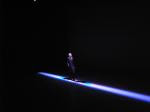 |
| Adapting for Distortion. Dancer Hiroaka Umeda. Photo by Alex. |
Call me old-fashioned, but to me, dance is about human bodies. Bodies that move. Not to discredit the power of stillness - which Japanese choreographer
Hiroaka Umeda used to good effect - but what excites me about dance is bodies and all the crazy things that they can do, both on their own and with other bodies - their kinesthetics, their physical force, the way they use momenteum and power.
So when a solo dance piece is about the body subsumed by technology - to sum up
Umeda's first solo,
Adapting for Distortion, in the most basic of terms - I find it hard to get excited. The work was clearly conceptualised to an inch of its life. Huge black and white grids filtered across the backdrop and floor continuously for the 30 minute solo.
Umeda barely moved - he was a small, swirling blip in the middle of the stage, amidst the repetitive grids and he stayed in the same low-level dynamic for the whole dance. I don't think his feet ever left the one spot and he let the texture of the projections filter over, into and above him. He did dance a little bit with a ripply hip-hop aesthetic (elements of popping and locking, some fluid body undulations), but it was so far away and, like the projections, so repetitive that I felt like I got all that the work had to give within the first 5 to 10 minutes.
Umeda's second solo,
Haptic, held more interest mainly because it had more variety of states. It also had big washes of intense colored lights, moments when Umeda's body was the focus and the sense that the work wasn't just all about computer projections. There was much more interplay of moving body with background. In
Haptic I could see
Umeda's actual choreography - and there was more going on dynamically and spatially than in
Adapting for Distortion.
 |
| Haptic. Dancer Hiroaka Umeda. Photo by Shin Yamagata. |
A program of two solos by the same dancer/choreographer to music by the same composer (
S20) was a dangerous proposition. Even one of these solos paired with a ensemble work would have been okay. Unfortunately, monotony was the theme of the day and the double bill left me wanting more. I know some audiences loved this singularity of vision and others found the theoretical implications of the technological/human relationship fruitful. I wish I could have been more excited myself.
The comparisons between
Adapting for Distortion & Haptic to
Chunky Move's
Glow and
Mortal Engine are fair to some degree, as they all work with interactive technology. From my very un-technological perspective, the
CM works felt truly interactive, with the dancers movements affecting the laser/light projections while
Umeda's projections seemed more layered onto movement than integrated into movement. The
CM pieces also conveyed a plethora of emotions, images and human interactions that were absent in
Umeda's work. When dance employs technology, the technology has to add something that the dance alone cannot, or at least present the dance in a different way than the dance would otherwise be shown.
Umeda's work felt like a visual art instillation, the kind of thing you would walk by in a gallery, watch for a few minutes and then move on.
Maybe if I had wandered into
Adapting for Distortion & Haptic at ACCA I would have appreciated it more.
Adapting for Distortion & Haptic
Melbourne International Arts Festival
The CUB Malthouse, Merlyn Theatre
14 - 16 October 2010







